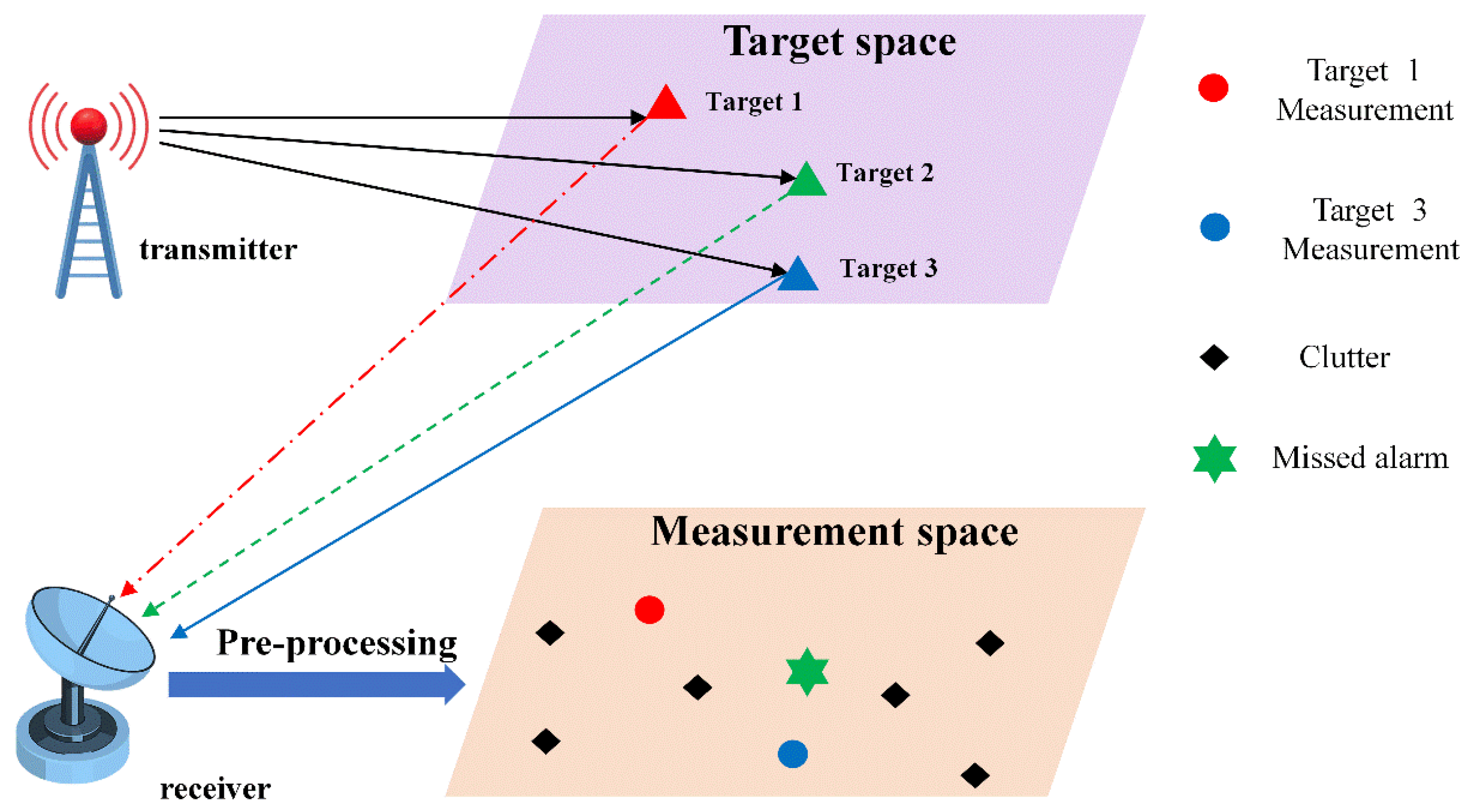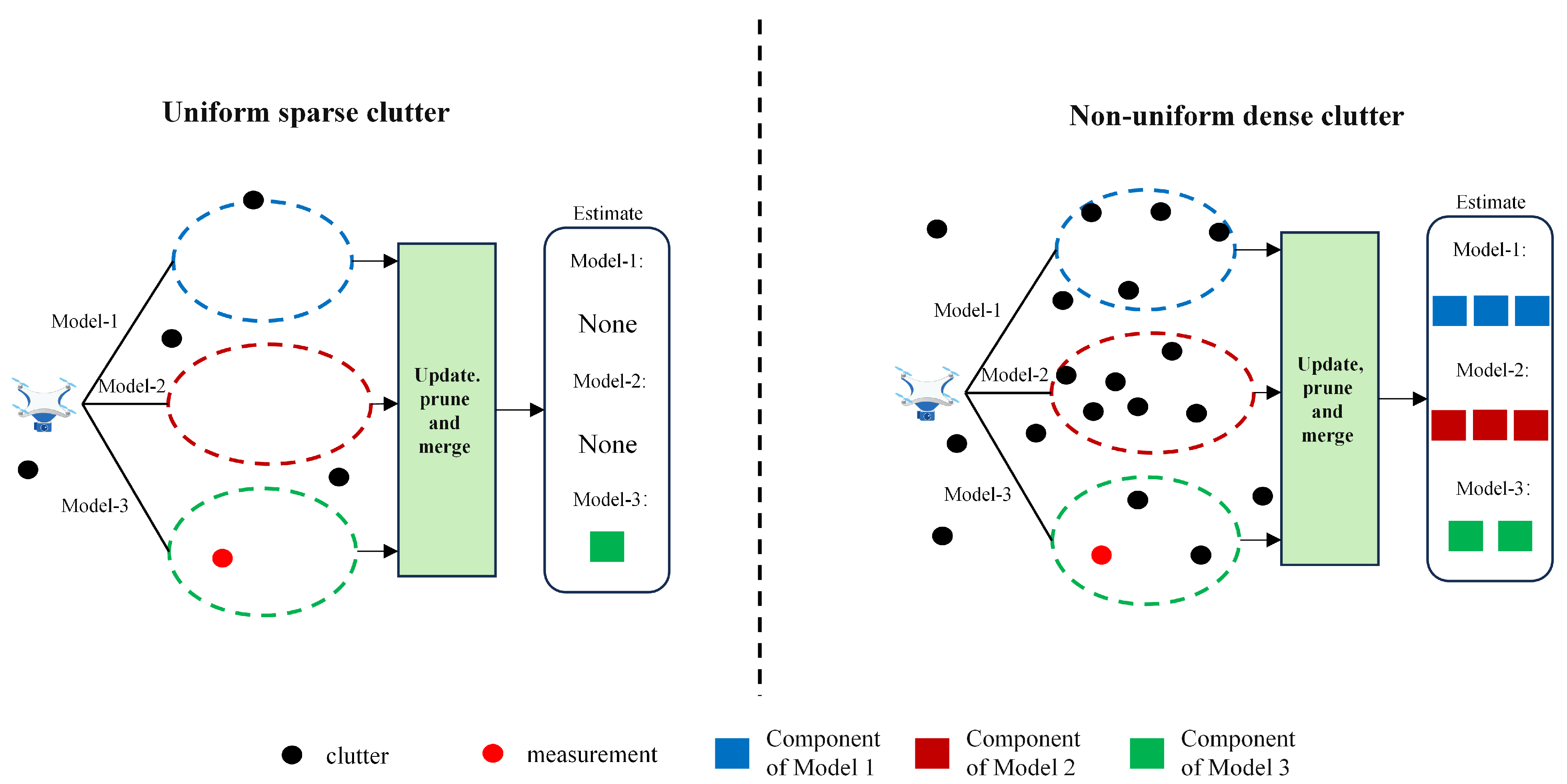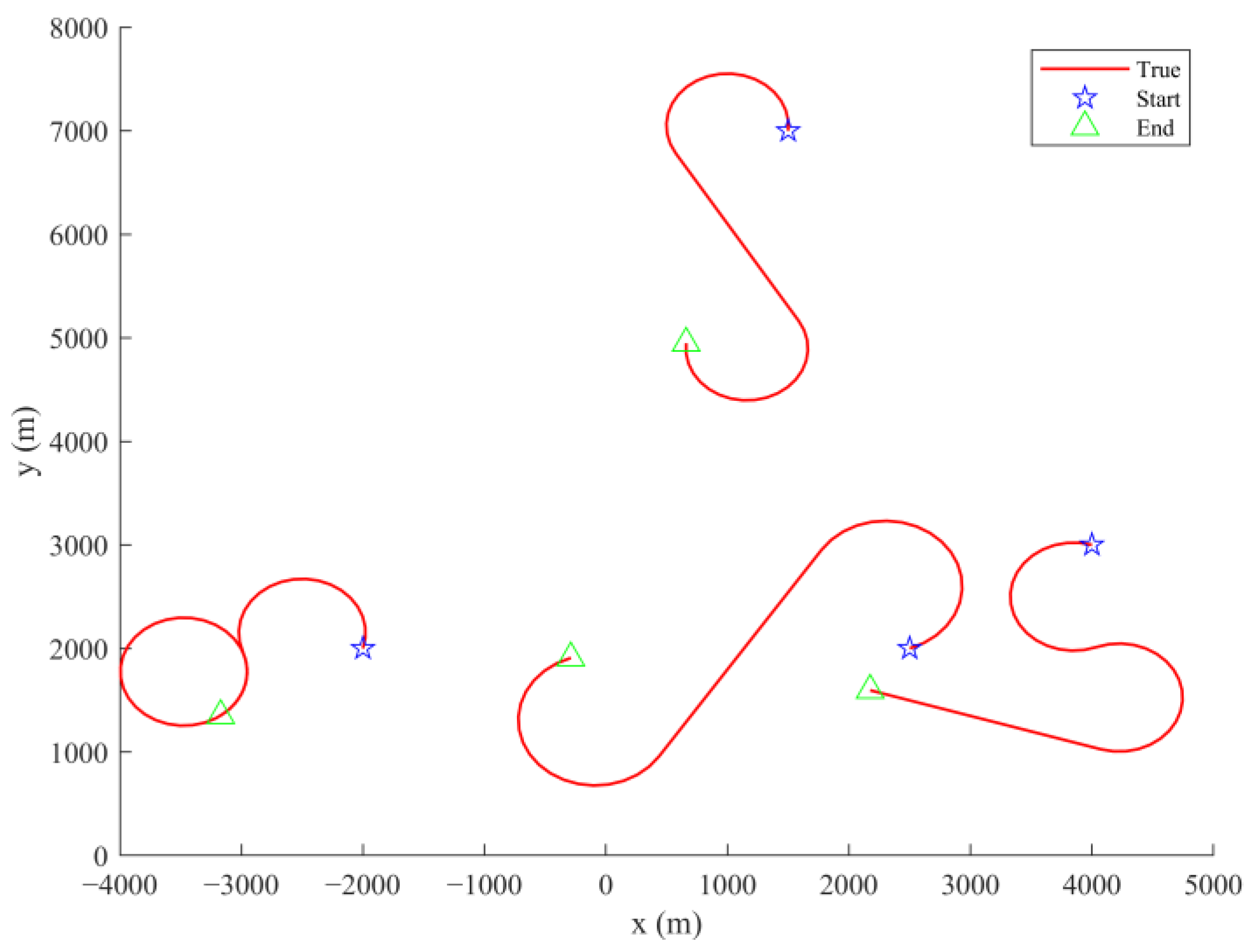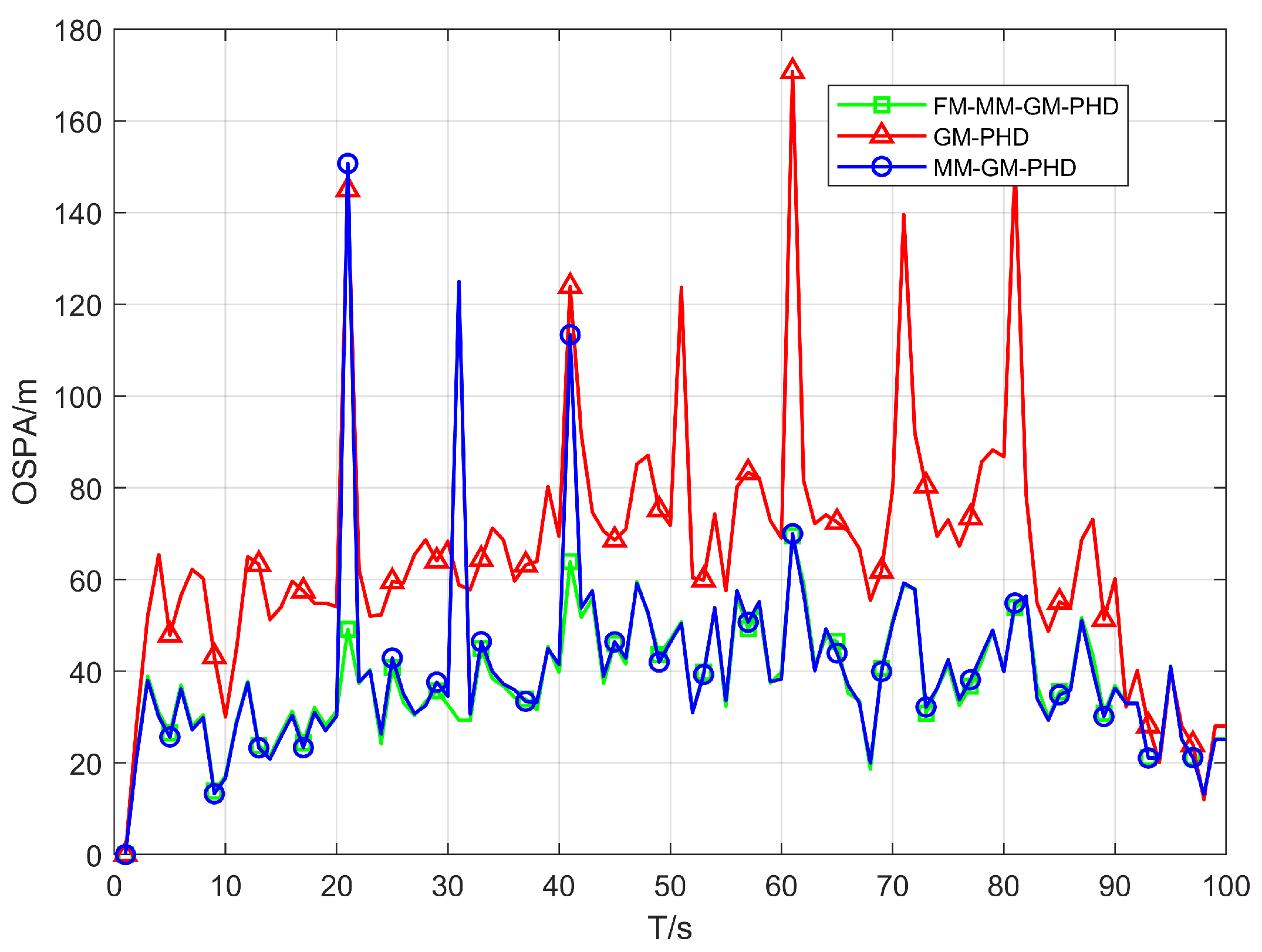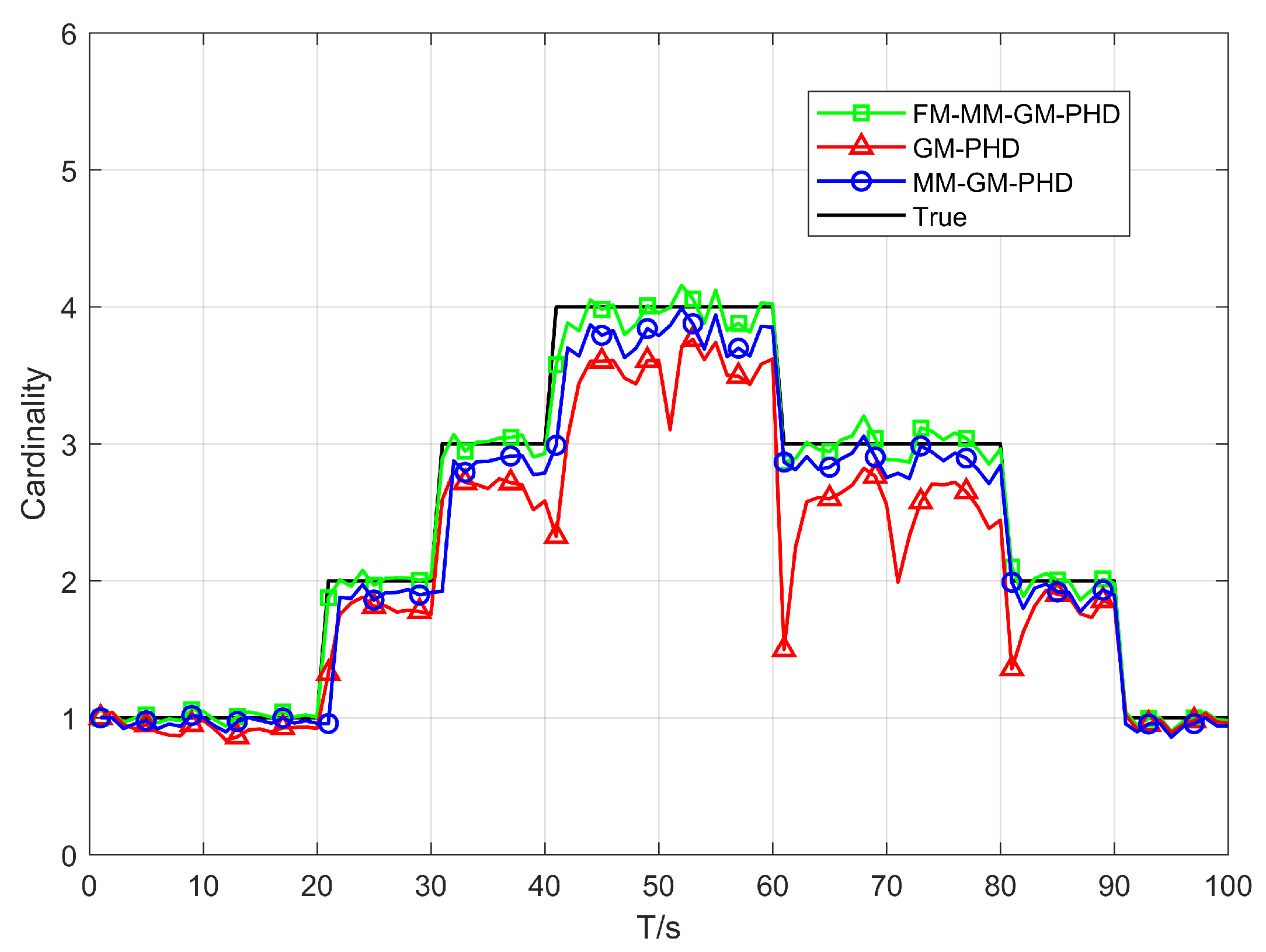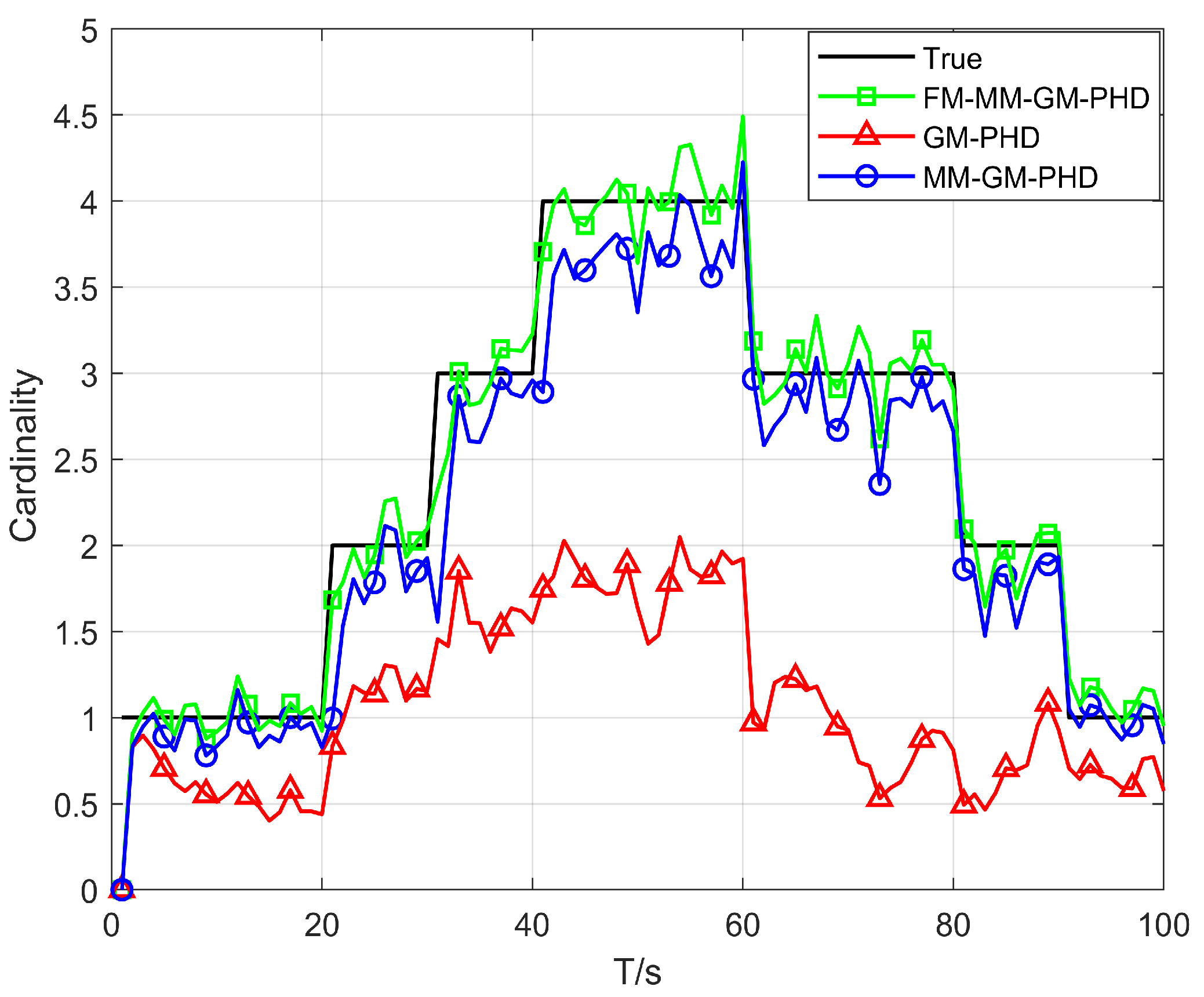1. Introduction
Traditional active radar suffers from inherent limitations. Its radiated signals are easily intercepted, and it offers weak anti-interference capability. In complex environments, this radar’s performance faces severe restrictions. Passive radar uses external signals, and this approach offers distinct advantages, including outstanding concealment and low cost. Research on target tracking algorithms for passive radar holds significant value in the complex electromagnetic environment.
In the field of passive radar tracking, multi-target tracking has always been a highly challenging problem [
1]. The complexity of this problem stems from the need to evaluate the motion characteristics of multiple targets simultaneously based on measurements. The uncertainty of target motion and the variation in the number of targets further compound these intractable tracking difficulties.
Conventional multi-target tracking (MTT) approaches rely on data-association techniques [
2,
3,
4], including multiple hypothesis tracking (MHT), joint probability data association (JPDA), and probability data association (PDA) [
5,
6]. Such methods break down the MTT challenge into individual single-target problems, addressing the task of assigning measurements to targets. Nevertheless, their complexity increases sharply as the number of measurements increases. Over recent years, MTT methods based on random finite sets (RFS) have received widespread attention since they can naturally handle changes in the number of targets and measurement uncertainty [
7,
8,
9]. Some algorithms such as probability hypothesis density (PHD) [
10,
11,
12], cardinalized probability hypothesis density (CPHD) [
13,
14,
15], and generalized labeled multi-Bernoulli (GLMB) [
16,
17,
18] can directly estimate the state, number, and trajectory information of multiple targets without data association. PHD and CPHD are widely used in engineering due to their low implementation difficulty and low computational complexity.
The above-mentioned RFS algorithms mainly focus on tracking targets using a single motion model. However, a single model is insufficient to effectively track maneuvering targets, necessitating the use of multiple models to modify their motion [
19]. The interacting multiple model (IMM) method was introduced in [
20,
21] to sacrifice complexity for higher tracking accuracy. In [
22,
23], the ordinary multiple model (MM) method was presented to quickly track multiple maneuvering targets through sequential Monte Carlo (SMC) and Gaussian mixture (GM). While the SMC method has better tracking accuracy in non-linear problems, target number estimation with SMC degrades due to unreliable clustering operations. In engineering, the MM-PHD method is widely used in the form of GM solution for its high reliability.
In the modern complex electromagnetic environment, the distribution of clutter is often non-uniform. In uniform clutter environments, MM-GM-PHD effectively handles target motion changes. However, dense clutter in non-uniform clutter misleads the multiple model method. This generates false targets and weakens tracking performance. Dense clutter fills multiple model gates with false measurements and leads to severe misestimation of target number, states, and motion models. Existing non-uniform clutter suppression techniques at the radar data processing stage [
24,
25,
26] apply to single-target motion model. These algorithms tend to inadequately address the limitations of the multiple model PHD method in non-uniform clutter. Feature-aided modification of the target likelihood function provides a promising approach to address these challenges. Tian et al. integrated direction-of-arrival (DOA) and frequency features to construct a joint position-feature likelihood function, improving measurement association [
27]. Zheng et al. utilized RCS and Doppler characteristics to adjust measurement likelihood weights in space-based target tracking [
28]. Yu and Xi-an employed spread angle measurements to reformulate the likelihood model for sonar extended targets in heterogeneous fusion [
29]. Bai et al. designed an SNR-aware factor to modify the likelihood function against interference [
30]. Wei et al. developed a hybrid likelihood model to track coexisting point and extended targets [
31]. Inspired by the above methods, we propose a feature-matching MM-GM-PHD (FM-MM-GM-PHD) algorithm. It corrects measurement likelihood using target RCS and Doppler features. The filter effectively tracks maneuvering targets and solves the performance degradation problem of the multiple model PHD filter in non-uniform clutter.
Additionally, passive radar in complex environments is prone to miss alarms caused by external interference [
32]. This significantly increases tracking difficulty. This paper proposes a missed-alarm correction mechanism. It can correct the estimation of target states according to historical multi-target states, thus reducing the impact of missed alarms on tracking.
The main contributions are as follows:
- (1)
For passive radar, we propose a feature-matching multiple model PHD tracking method that combines RCS and Doppler features. This method solves the issue of abnormal component weights of multiple models in non-uniform clutter environments which are likely to generate false targets.
- (2)
For non-uniform clutter environments, we improve the pruning and merging of Gaussian components and reduce the likelihood of mis-merging through adaptively adjusting the merging threshold based on Gaussian component weights.
- (3)
To tackle the issue of missed alarms concerning targets, we introduce a missed-alarm correction mechanism. By leveraging the variations in the target’s motion states within the prior two frames, this mechanism adaptively adjusts the predicted state.
4. Simulation
In this section, we evaluate the performance of the proposed algorithm. The tracking capability of the FM-MM-GM-PHD filter for multiple maneuvering targets is assessed under both uniform and non-uniform clutter scenarios. Experiments demonstrate that this method can precisely monitor multiple maneuvering targets and determine the exact number of targets in both clutter environments. Herein, the Optimal Sub-Pattern Assignment (OSPA) distance is employed to quantify the algorithm’s tracking performance, defined as
where
denotes the set-to-set distance between
and
. The parameter
regulates the sensitivity to track loss, and the cut-off parameter
specifies penalty for positioning and cardinality estimation errors. In the experiments of this paper, the above parameter is set to
,
.
deliberately intensifies sensitivity to target maneuvering by quadratically amplifying state estimation errors during kinematic transitions. Meanwhile,
serves dual purposes: it aligns with the spatial resolution of passive radar systems while preventing premature truncation of localization deviations, thereby preserving metric fidelity to true tracking errors.
The RCS–Doppler-assisted feature-matching mechanism extracts two discriminative target characteristics to augment measurement association. RCS values are obtained through logarithmic conversion of the received-to-transmitted power ratio, incorporating bistatic range and antenna gain parameters. Simultaneously, Doppler frequency is derived from radial velocity measurements relative to the receiver.
In the simulation, one hundred independent Monte Carlo runs were conducted, with each experiment spanning a duration of 100 s and the sampling time interval being
. The standard deviation of the bistatic range noise
the standard deviation of the bistatic velocity noise
and the standard deviation of the angular noise
. The clutter is Poisson-distributed in a two-dimensional space, and the RCS likelihood function of the clutter satisfies the Rayleigh distribution. In the two-dimensional simulation scenario, four targets are set to have multiple maneuvers in space, with a total duration of 100 s. The target parameters are provided in
Table 1.
The parameters of the birth target model are given by
The pruning threshold is set to
in order to filter out negligible low-weight components, and the maximum value of components is limited to
for constraining computational complexity while supporting multi-target tracking. The target trajectory is given in
Figure 5.
4.1. Scenario 1
In Scenario 1, we conduct a performance test in a uniform clutter scenario with the number of clutter per frame
and a detection probability
. We benchmark the performance of the conventional GM-PHD, MM-GM-PHD, and our proposed FM-MM-GM-PHD filter. The tracking and cardinality estimation accuracies of the three methods are illustrated in
Figure 6 and
Figure 7. In uniform clutter scenario, the OSPA distance curve of the FM-MM-GM-PHD filter is very close to the MM-GM-PHD filter, and both are significantly better than the GM-PHD filter. This is because the multi-model approach can handle the maneuvers of multiple targets. However, the MM-GM-PHD filter has obvious spikes at some moments, while the proposed algorithm does not. In terms of cardinality estimation, the MM-GM-PHD and GM-PHD both underestimate target numbers. The latter suffers from severe underestimation due to target maneuvers. By contrast, the FM-MM-GM-PHD filter accurately estimates target cardinality thanks to its missed-alarm correction mechanism. Moreover, the method we propose can rapidly pinpoint the emergence and vanishing of targets.
Figure 8 illustrates the computational time of three filters within a uniform clutter environment. As evident from the results, the computational complexity of the proposed algorithm aligns with that of the MM-GM-PHD, while both are more computationally intensive than the GM-PHD.
To test the performance of the proposed missed alarm mechanism in a uniform scenario, we compare the proposed algorithm with other filters under low detection probability.
Figure 9 and
Figure 10 show the OSPA and cardinality estimation results under the condition of a detection probability of 0.7, respectively. When the detection probability is low, GM-PHD can hardly maintain continuous tracking and significantly underestimates the number of targets. The proposed FM-MM-GM-PHD algorithm still remains comparable to MM-GM-PHD in terms of OSPA, but the latter more severely underestimates the targets in cardinality estimation.
Through its missed-detection correction mechanism, the proposed algorithm generally attains accurate target number estimation under low detection probabilities, with negligible impact on the OSPA distance.
4.2. Scenario 2
Scenario 2 benchmarks the proposed algorithm against GM-PHD and MM-GM-PHD in a non-uniform clutter scenario. As
Figure 11 illustrates, the scenario involves uniform clutter combined with dense Gaussian-distributed clutter, where the central position of the Gaussian non-uniform clutter is randomly located on each target trajectory. The detection probability is fixed at
. Across different experiments, the number of non-uniform clutter
in each area per frame was set to 5, 10, and 20, respectively, for each trial.
Figure 12 and
Figure 13 show the average OSPA distances for different algorithms under different non-uniform clutter conditions. It indicates that when the number of non-uniform clutter per frame in each area
, FM-MM -GM-PHD slightly better than MM-GM-PHD while the OSPA of the GM-PHD filter is much higher than the other methods, which is caused by target maneuvers. In terms of cardinality estimation, FM-MM-GM-PHD has the most accurate cardinality estimation ability and can detect the appearance of new targets first. As the number of non-uniform clutter increases, the OSPA of MM-GM-PHD rises rapidly, and the cardinality estimation is significantly overestimated. This occurs because the rise in dense clutter within the multi-model gate causes the creation of false targets. In contrast, FM-MM-GM-PHD always maintains good performance.
Figure 14 and
Figure 15 illustrate the performance of the proposed algorithm and comparative methods in a non-uniform clutter under different detection probabilities. With a fixed number of uniform clutter per frame
and non-uniform Gaussian-distributed clutter per frame
in each area, the detection probabilities
are set as 0.98, 0.88, and 0.78, respectively. As illustrated in
Figure 14, we compared the OSPA distances of different algorithms with declining detection probability. It indicates that as the detection probability decreases, the OSPA distances of all algorithms increase. However, the FM-MM-GM-PHD filter is affected the least and still has a relatively small OSPA distance compared with other filters. This is because the missed-alarm correction mechanism of the proposed method can effectively deal with target missed alarms.
Figure 15 shows the estimation of the cardinality of targets by all filters under different detection probabilities. The FM-MM-GM-PHD filter still has the highest estimation accuracy compared with other filters and is quite close to the true value of the cardinality of targets. As the detection probability decreases, the performance of other filters in estimating the cardinality of targets drops sharply. The MM-GM-PHD filter severely overestimates the number of targets due to the multi-model approach.
However, our experiments have also identified specific edge cases worth noting. Specifically, when targets exhibit crossing trajectories and share highly similar RCS and Doppler features, the current feature-matching framework shows reduced discriminability. In such scenarios, inadequate adjustment of features can lead to false association between measurements and targets, resulting in overestimation or underestimation of target cardinality.
Figure 16 also illustrates the real-time computation times of different filters under varying non-uniform clutter conditions. In all scenarios, the GM-PHD filter has the shortest computation time because it does not need to adopt a multi-model approach to consider targets. When the non-uniform clutter count is 5, the proposed algorithm is slightly more computationally efficient than MM-GM-PHD. As the non-uniform clutter count increases, the computation time of the proposed algorithm becomes significantly shorter. This is because the proposed algorithm suppresses false targets via target features, thereby reducing unnecessary estimation of false targets. In contrast, as dense non-uniform clutter increases, the traditional MM-GM-PHD—unable to distinguish true from false targets—processes a large number of components simultaneously through PHD filtering, greatly increasing computation time.
Figure 17 presents the comparative computational efficiency of three distinct filters under escalating non-uniform clutter conditions. In the non-uniform clutter conditions, the proposed algorithm demonstrates progressively superior computational performance, particularly evident when
. Crucially, the results confirm that our approach maintains stable processing times even at peak clutter achieving up to 60% reduction compared to MM-GM-PHD. Collectively, these computational advantages complement the method’s established tracking accuracy and cardinality estimation superiority in non-uniform clutter environments.
4.3. Computational Complexity Analysis
The computational complexity of the MM-GM-PHD and proposed FM-MM-GM-PHD filters is quantified using floating-point operations (FLOPs) as the metric, following the approach in. For the MM-GM-PHD filter, its complexity arises primarily from multi-model operations; each of the M motion models independently performs prediction and update steps, contributing , where is the state dimension, is the measurement dimension, and is the number of Gaussian components. Additional overhead comes from model probability fusion and scaled pruning and merging operations due to the increased number of components across models Consequently, the total complexity of MM-GM-PHD is , which grows significantly with non-uniform clutter intensity as increases due to false measurements. In contrast, the FM-MM-GM-PHD filter introduces two key optimizations to reduce complexity while maintaining performance. First, feature matching (using RCS and Doppler features,) adds a negligible overhead of . Second, adaptive pruning suppresses false components. Both reduce the effective number of Gaussian components to , where . The missed-alarm correction mechanism contributes a minor cost of Thus, the total complexity of FM-MM-GM-PHD is , and the memory requirement is Meanwhile, the actual computational time of the algorithm is not only related to model complexity but also to many other factors, such as memory access cost, hardware characteristics, software implementation, and system environment. Model complexity cannot accurately measure the estimation speed of the proposed algorithm. However, the simulation experiments in this paper further well demonstrate the advantages of the proposed algorithm in non-uniform clutter environments. The reduction in effective components via makes FM-MM-GM-PHD significantly more efficient than MM-GM-PHD, with computational time decreasing by 60% in dense non-uniform clutter.
4.4. Results Discussion
As the amount of non-uniform clutter increases, the conventional MM-GM-PHD algorithm will significantly overestimate the number of targets, resulting in a large number of false targets. This issue not only substantially increases the computational load of subsequent filtering processes but also causes a great deal of unnecessary estimation resources to be wasted on false targets. In contrast, the method proposed in this paper can effectively mitigate the negative impacts of non-uniform clutter on multi-model approaches, enabling accurate estimation of the number and states of multiple maneuvering targets. Regarding computational complexity, the proposed method is comparable to MM-GM-PHD in non-uniform clutter environments. However, as the number of non-uniform clutter further increases, the computational time advantage of FM-MM-GM-PHD becomes increasingly prominent.
Quantitative analysis confirms the FM-MM-GM-PHD filter’s significant advantages over conventional MM-GM-PHD in non-uniform clutter. Under , the proposed method reduces cardinality estimation error by about 90% and lowers OSPA distance by about 75%. This stems from RCS–Doppler feature matching, which suppresses approximately 97% of clutter-induced false targets through joint likelihood ratios, while the missed-alarm correction mechanism maintains cardinality deviations below 5% when the detection probability is low. Computational efficiency improves by approximately 60% at high clutter loads due to reduced false component processing. The key limitations involve moderate precision degradation during extreme non-linear maneuvers such as high-g turns, alongside reliance on measurable RCS and Doppler features. Future work will integrate particle filtering to enhance non-linear tracking capability in passive radar bistatic geometries, particularly for swarm targets with interactive motions.
5. Conclusions
This paper proposes an RCS–Doppler-assisted multi-model PHD filter for passive radar. It suppresses false targets in non-uniform clutter by adaptively weighting Gaussian components using radar echo features. Moreover, the missed-detection correction mechanism integrated into the proposed algorithm compensates for measurement loss using targets’ historical kinematic states. Simulation results demonstrate that the proposed algorithm significantly outperforms traditional MM-GM-PHD filter and GM-PHD filter in both uniform and non-uniform clutter scenarios. Specifically, in non-uniform environments with dense Gaussian clutter, its OSPA error is approximately 30% lower than that of traditional algorithms, and it is particularly accurate in estimating target cardinality. As detection probability continues to decrease, the proposed algorithm also exhibits stronger robustness in both OSPA and cardinality estimation compared to other methods.
Future work will focus on developing interaction-aware motion models to enhance tracking performance in target-congested scenarios, with applications for swarm tracking.
